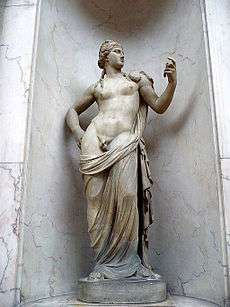Gynomorph
Gynomorph is a word used to describe an organism with female physical characteristics.

Mythology
In Greek mythology and religion, a gynomorph was a bi-gendered god with both masculine and feminine characteristics. Gynomorphs were portrayed as effeminate young males, like Dionysos, a masculine god who possessed distinctly feminine features. Gynomorphs retained the creative capacity of female divinities, they had cosmic wombs, but they also possessed the inseminating abilities attributed to male divinities.[1]
Biology
In biology, a gynomorph is an organism with female physical characteristics, whereas an andromorph is an organism with male physical characteristics. For instance, some female damselflies show colour variations typically found in males. Andromorphs, by resembling males, are thought to benefit from avoiding male harassment. Some authors have proposed that this benefit is offset by a higher probability of detection for andromorphs compared to gynomorphs owing to differences in body colouration.[2]
References
- David Hillman (2014). Hermaphrodites, Gynomorphs and Jesus. Ronin Publishing. ISBN 1579511856.
- Van Gossum, H; Stoks, Robby; De Bruyn, L (July 2004). "Conspicuous body coloration and predation risk in damselflies : are andromorphs easier to detect than gynomorphs?".